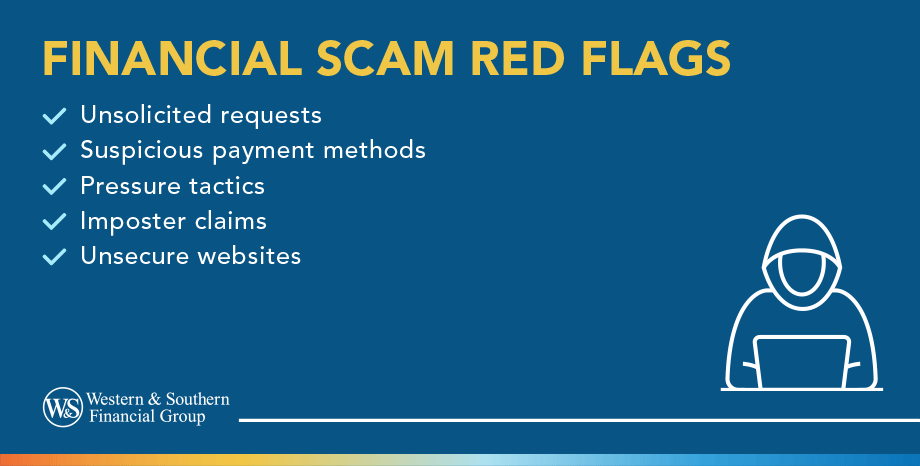

Key Takeaways
- Consumers report billions in financial scam losses annually, and scams are becoming increasingly sophisticated.
- Technology, social engineering and artificial intelligence tools are giving scammers new ways to deceive people.
- Warning signs include urgent payment requests, unusual payment methods like gift cards or crypto and impersonation of trusted organizations.
- Safer practices such as limiting personal details, verifying sources, enabling two-factor authentication and checking credit reports may help lower risk.
Why Financial Scams Are on the Rise
Online banking, mobile payments and social media have made managing money easier. But they’ve also created opportunities for fraud. According to the Federal Trade Commission, consumers reported losing over $12.5 billion to financial scams in 2024 alone.1
Common Reasons Scams Spread
- Convenience of technology: Faster money transfers mean quicker fraud.
- Social engineering tactics: Scammers exploit emotions like fear and trust.
- Artificial intelligence tools: AI face-swapping scams and voice cloning are making fraud feel more personal and believable.
Red Flags To Watch For
Spotting warning signs early can prevent major losses. Some red flags include:
- Unsolicited requests: A phone call or email demanding immediate payment.
- Suspicious payment methods: Gift cards, crypto tokens or money transfers.
- Pressure tactics: Being told there’s “suspicious activity” on your bank account or that you must act quickly.
- Imposter claims: Someone pretending to be from Medicare, the IRS or your bank.
- Unsecure websites: Scam websites that don’t use secure .gov or https connections.
Types of Financial Scams & How They Work
Phishing Scams
These include emails, texts or messages that look official but attempt to steal personal financial information like credit card numbers or login credentials. For instance, you might get an email that looks like it’s from your bank asking you to “verify your account” by clicking a link and entering your login details.
Tech Support Scams
Fraudsters claim your device has a virus and request remote access, sometimes even charging for fake antivirus software. A common example is a pop-up warning of a serious infection that urges you to call a number, where the scammer then pressures you into paying for unnecessary repairs.
Investment Scams
Investment scams may involve promises of high returns from crypto tokens, Ponzi schemes or fraudulent investment products. These might appear as online ads promoting a “guaranteed” crypto opportunity that claims your money will double in weeks if you transfer it to a digital wallet.
Romance & Sweetheart Scams
Scammers attempt to build relationships online, then request money transfers under emotional pretenses. For example, someone you meet on a dating site may claim they want to visit you, but suddenly say they can’t afford travel costs and ask you to send money.
Government & Bank Imposter Scams
Fraudsters use caller ID spoofing to appear legitimate, claiming you owe taxes, have a Medicare issue or face “suspicious activity” in your bank account. In many cases, the caller pretends to be from your bank and asks for your debit card PIN to “fix” the problem.
How To Protect Yourself From Financial Scams
Secure Your Personal Information
- Limit sharing: Be careful what personal details you post on social media.
- Use authentication options: Enable two-factor authentication for online banking and credit reports.
- Check credit reports regularly: Monitoring can help spot identity theft early.
Verify Before You Pay
- Confirm through official sources: Use secure .gov websites or bank numbers from official statements.
- Be skeptical of gift card or money transfer requests: These are common in fraudulent activities.
- Ask for written documentation: Scammers typically avoid providing it.
Use Security Tools
- Install antivirus software: This may help detect threats before they spread.
- Consider authentication apps: They add an extra layer of security beyond passwords.
- Watch caller ID carefully: Spoofing makes scams look real; always verify.
Conclusion
Financial scams are evolving, but so are the tools to fight them. By learning how to spot and avoid financial scams, you may reduce the risk of identity theft, online banking fraud and fraudulent activities that threaten your security. Staying alert, asking questions and verifying information can help keep your money safer in a digital-first world.
Take advantage of a free financial review. Discuss retirement goals, explore investment opportunities and evaluate life insurance options. Get My Free Financial Review
Frequently Asked Questions
How do I know if a phone call is a scam?
What should I do if I gave out my bank account details?
Can artificial intelligence be used in scams?
What’s the safest way to handle suspicious activity alerts?
What is the best payment method to not get scammed?
What are three excuses a scammer uses?
- Urgency: Claiming “suspicious activity” on your bank account that requires immediate action.
- Authority: Pretending to be from the IRS, Medicare, or your bank.
- Emotion: Using fear, guilt, or affection, such as in sweetheart scams or fake emergencies.
Sources
- New FTC Data Show a Big Jump in Reported Losses to Fraud to $12.5 Billion in 2024. https://www.ftc.gov/news-events/news/press-releases/2025/03/new-ftc-data-show-big-jump-reported-losses-fraud-125-billion-2024






















